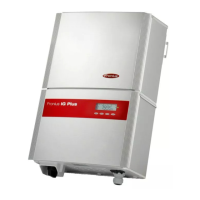25
EN-US
Choosing a Loca-
tion for Inside In-
stallation
Choosing a loca-
tion for outdoor
installation
During certain operation phases the inverter may produce a slight noise. For this reason
it should not be installed in an occupied living area.
Do not install the inverter in:
- areas with large amounts of dust
- areas with large amounts of conducting dust particles (e.g., iron filings)
- areas with corrosive gases, acids or salts
- areas where there is an increased risk of accidents, e.g., from farm animals (horses,
cattle, sheep, pigs, etc.)
- stables or adjoining areas
- storage areas for hay, straw, chaff, animal feed, fertilizers, etc.
- storage or processing areas for fruit, vegetables or winegrowing products
- areas used in the preparation of grain, green fodder or animal feeds
- greenhouses
NEMA 3R protection means that the inverter is not susceptible to water spray from any
direction.
However, the manufacturer recommends, if possible, that the inverter not be exposed to
direct moisture or to a direct water jet (e.g., from sprinklers).
In order to protect the display, the inverter should not be exposed to direct sunlight. Ide-
ally, the inverter should be installed in a protected location, e.g., near the solar modules
or under a roof overhang.
Do not install the inverter:
- where it can be exposed to ammonia, corrosive gasses, acids or salts (e.g., fertilizer
storage areas, vent openings of livestock stables, chemical plants, tanneries)

